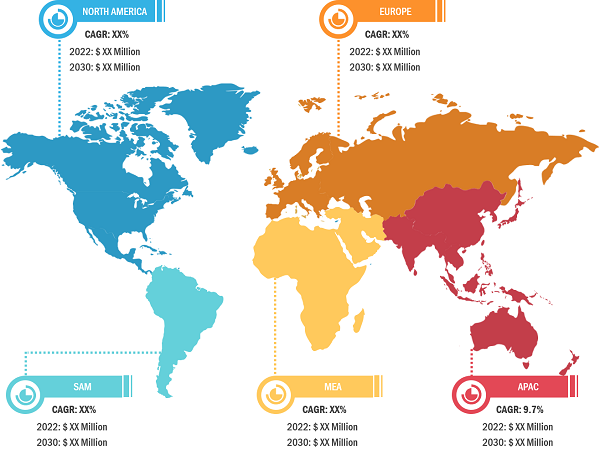Growing Inclination Towards Eco-friendly Refrigerant-based Refrigeration System Boosts Industrial Refrigeration Equipment Market Growth
According to our latest study on “Industrial Refrigeration Equipment Market Forecast to 2030 – COVID-19 Impact and Global Analysis – by Type, Refrigerant Type, and Application,” the industrial refrigeration equipment market size was valued at US$ 19.1 billion in 2022 and is expected to reach US$ 36.8 billion by 2030. The industrial refrigeration equipment market is expected to record a CAGR of 8.5% from 2022 to 2030.
The growing importance of eco-friendly practices and sustainability is increasing the demand for refrigeration systems that use environmentally friendly refrigerants. This shift in end-user preferences drives the market players to develop and offer more energy-efficient and environmentally conscious solutions. There is a rise in environmental concerns and regulations aimed at reducing the impact of traditional refrigerants, such as hydrofluorocarbons (HFCs), on the ozone layer and climate. As regulations and awareness about climate change continue to become more stringent, businesses are adopting these systems to align with greener practices and reduce their carbon footprint. Hence, the adoption of natural refrigerants, such as hydrocarbons (propane and isobutane) and ammonia, is increasing across the globe. These substances have substantially lower Global Warming Potential (GWP) than HFCs. Industries are increasingly transitioning to these alternatives to adhere to environmental regulations and minimize their carbon footprint.
Industrial Refrigeration Equipment Market – by Region, 2022 and 2030
Industrial Refrigeration Market Size and Forecast (2020 - 2030), Global and Regional Share, Trend, and Growth Opportunity Analysis Report Coverage: By Type (Mechanical-Compression Refrigeration Systems, Evaporative Cooling, Absorption, and Thermoelectric), Refrigerant Type [Ammonia - R717, Carbon Dioxide (CO2) - R744, and Hydrocarbons - HCs], and Application (Food and Beverages, Pharmaceutical, Chemical and Petrochemical, District Cooling, Data Centres, Electricity Production, and Others), and Geography
Industrial Refrigeration Market Regional Overview by 2030
Download Free Sample
Source: The Insight Partners Analysis
Moreover, many companies are investing in innovative technologies that utilize these eco-friendly refrigerants. For instance, CO2-based refrigeration systems, known as transcritical CO2 systems, are widely deployed in supermarkets and cold storage facilities. These systems use CO2 as a refrigerant, which has an extremely low GWP and zero ozone depletion potential. For instance, in May 2023, Frascold’s production facilities launched a new chiller with environmentally friendly refrigerant. By implementing such systems, businesses can showcase their commitment to sustainability while benefiting from reduced energy consumption and operating costs.
Further, government initiatives and international agreements such as the Kigali Amendment to the Montreal Protocol have accelerated the adoption of eco-friendly refrigerants. For example, in August 2023, The Telangana Central Government Institute launched a novel initiative to promote the innovation of sustainable cooling systems and accelerate the deployment of energy-efficient refrigeration for food and vaccine supply chains across India. This initiative has encouraged industries to proactively seek alternatives. Thus, the rising inclination towards eco-friendly refrigerant-based refrigeration systems is driving the industrial refrigeration equipment market growth.
The industrial refrigeration equipment market is categorized on the basis of type, refrigerant type, application, and geography. Based on type, the industrial refrigeration equipment market is segmented into evaporative cooling, mechanical, compression refrigeration systems, absorption, and thermoelectric. By refrigerant type, the industrial refrigeration equipment market is segmented into ammonia–R717, carbon dioxide (CO2)–R744, and hydrocarbons–HCs. Based on application, the industrial refrigeration equipment market is categorized into district cooling, electricity production, chemical and petrochemical, pharmaceutical, food and beverages, data centers, and others. The industrial refrigeration equipment market, based on geography, is categorized into North America, Europe, Asia-Pacific, the Middle East & Africa, and South America.
Samifi France SAS, Johnson Controls International Plc, Jean Paumier et Fils Ets, Danfoss AS, Honeywell International Inc, Copeland LP, Evapco Inc, Mayekawa Australia Pty Ltd, and BITZER Kuhlmaschinenbau GmbH are among the key players operating in the industrial refrigeration equipment market.
Contact Us
Phone: +1-646-491-9876
Email Id: sales@theinsightpartners.com